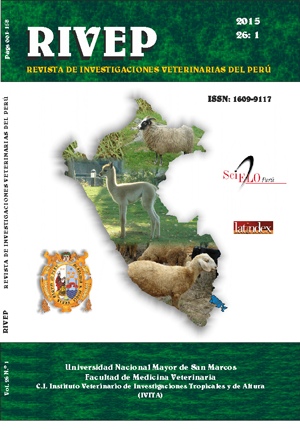Evaluation of ram sperm quality post-thawing by using two energy sources and two cryoprotectants
DOI:
https://doi.org/10.15381/rivep.v26i1.10942Keywords:
frozen semen, extenders, fructose, glucose, glycerol, ethylene glycolAbstract
The aim of this study was to evaluate the effect of two monosaccharides (fructose and glucose) and two cryoprotectants (glycerol and ethylene glycol) on semen quality after the cryopreservation process under a 2 x 2 factorial arrangement. The variables evaluated were progressive motility, viability, and acrosomal integrity. Motility was greater with the use of glycerol (65.5%) compared to the use of ethylene glycol (49.0%) (p<0.05); also, motility using fructose was higher with the use of fructose (59.3%) than when using glucose (55.1%) (p<0.05). Acrosomal integrity was superior with the use of glycerol (58.2%) compared with ethylene glycol (42.0%); also, acrosomal integrity was superior with the use of fructose (53.8%) than when using glucose (46.4%) (p<0.05). The energy source x cryoprotectant interaction was not statistically significant. The results showed that the use of glycerol as a cryoprotectant and fructose as an energy source more effectively prevent loss of semen quality during cryopreservation in comparison to ethylene glycol and glucose, respectively.Downloads
Downloads
Published
Issue
Section
License
Copyright (c) 2015 Luis Ruiz G., Rocío Sandoval M., Alexei Santiani A.

This work is licensed under a Creative Commons Attribution-NonCommercial-ShareAlike 4.0 International License.
AUTHORS RETAIN THEIR RIGHTS:
a. Authors retain their trade mark rights and patent, and also on any process or procedure described in the article.
b. Authors retain their right to share, copy, distribute, perform and publicly communicate their article (eg, to place their article in an institutional repository or publish it in a book), with an acknowledgment of its initial publication in the Revista de Investigaciones Veterinarias del Perú (RIVEP).
c. Authors retain theirs right to make a subsequent publication of their work, to use the article or any part thereof (eg a compilation of his papers, lecture notes, thesis, or a book), always indicating the source of publication (the originator of the work, journal, volume, number and date).










